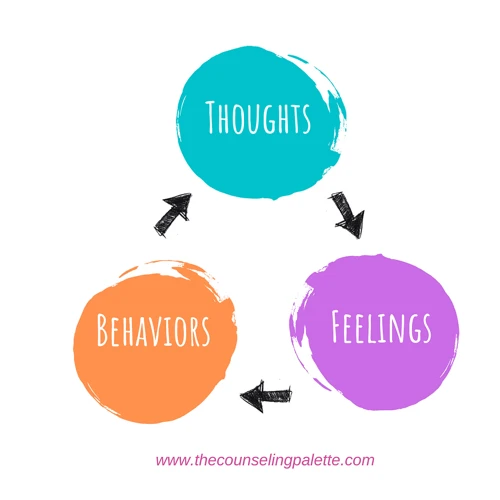As human beings, we experience a wide range of emotions that can influence our thoughts, behaviors, and overall well-being. But have you ever stopped to consider how these emotions manifest in our bodies? Our body sensations can provide valuable insights into our emotional experiences, yet many of us overlook this crucial aspect of emotional awareness. In this article, we will explore the role of body sensations in understanding our emotions, delving into the mind-body connection, the science behind sensations and emotions, and techniques for becoming more aware of our bodily experiences. Additionally, we will explore how incorporating spirituality into our emotional journey can enhance our overall emotional well-being.
Body Awareness and Spirituality
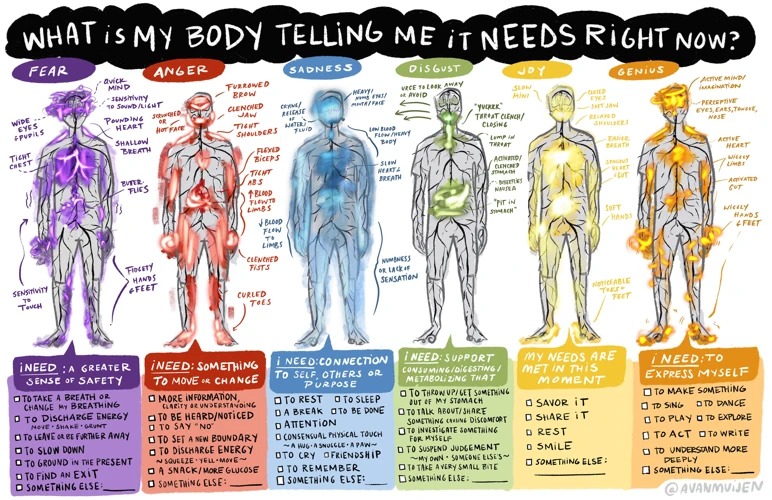
When it comes to understanding our emotions, the role of body sensations is often overlooked. However, for those who practice spirituality, body awareness is an essential part of their journey. The connection between the mind and body has been a topic of interest for centuries. While some view the body as nothing more than a physical vessel, others believe that it is a complex system that is intricately connected to the spiritual realm. In this section, we will explore the relationship between body awareness and spirituality, and how they both play a vital role in understanding our emotions.
The Mind-Body Connection
The relationship between the mind and body is complex and intertwined. The mind-body connection refers to the way in which our thoughts, emotions, and beliefs can influence our physical experiences and sensations, and vice versa. For example, when we experience stress or anxiety, we may notice physical sensations in our body, such as a tightness in the chest or a racing heart.
This connection between the mind and body has been studied extensively in the field of psychology, and research has shown that there is a strong correlation between our emotional and physical experiences. In fact, some experts believe that our emotions can manifest in physical symptoms.
Additionally, the mind-body connection can have a powerful impact on our overall health and well-being. By learning to recognize the ways in which our thoughts and emotions affect our physical experiences, we can take steps to improve our physical health and reduce symptoms of stress and anxiety.
One way to strengthen the mind-body connection is through mindfulness practices such as yoga or meditation. These practices can help us to become more aware of our bodies and the physical sensations that arise in response to our emotions.
It’s also important to note that the mind-body connection isn’t just a one-way street; our physical experiences and sensations can also influence our emotions and thoughts. For example, engaging in physical activities such as exercise or spending time in nature has been shown to have a positive effect on mental health and emotional well-being.
Ultimately, by recognizing and nurturing the mind-body connection, we can cultivate a greater sense of awareness and well-being in both our physical and emotional lives.
| Key Points: |
|---|
| – The mind-body connection refers to the way in which our thoughts, emotions, and beliefs can influence our physical experiences and sensations, and vice versa. |
| – There is a strong correlation between our emotional and physical experiences, with some experts believing that our emotions can manifest in physical symptoms. |
| – Mindfulness practices such as yoga or meditation can help to strengthen the mind-body connection by increasing awareness of our bodies and physical sensations. |
| – Physical experiences and sensations can also influence our thoughts and emotions, with activities such as exercise and spending time in nature having a positive impact on mental health. |
| – Nurturing the mind-body connection can lead to greater awareness and well-being in both our physical and emotional lives. |
Spirituality and Body Awareness
When we think of spirituality, we often think of practices such as meditation or prayer. But did you know that spirituality can also play a role in developing body awareness? Our physical bodies are not separate from our spiritual selves, and tuning into our bodies can lead to a deeper understanding of our spiritual selves.
One way spirituality can enhance body awareness is by promoting a sense of mindfulness. By staying present in the current moment, without judgment or distraction, we can become more aware of our bodily sensations. This can help us identify areas of tension or discomfort, and work towards releasing them.
Another way spirituality and body awareness are connected is through the recognition of the body as a vessel for the Divine. By seeing the body as a sacred entity, we may be more inclined to listen to its signals and appreciate its strengths and limitations.
Finally, spirituality can help us make sense of the meaning behind our physical experiences. Rather than simply noticing bodily sensations, we can also consider what they may be trying to tell us, emotionally or spiritually. For example, feeling a tightness in the chest could indicate anxiety or fear, whereas a warmth in the heart could indicate love or gratitude.
By incorporating spiritual practices into our daily routines, such as meditation or prayer, we can cultivate a deeper connection to our bodies and enhance our overall well-being.
The Science behind Sensations and Emotions
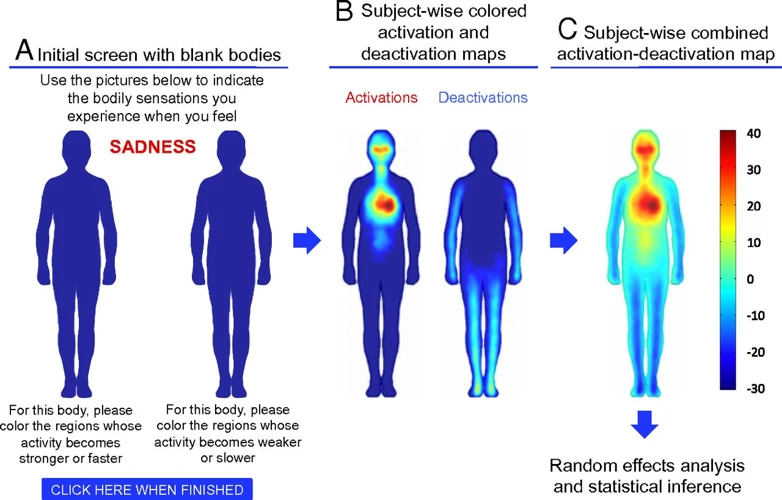
As humans, we experience a wide range of emotions throughout our lives. These emotions can be intense, overwhelming, and sometimes difficult to understand. However, recent scientific research has shed light on the connection between our bodily sensations and our emotional experiences. Understanding the science behind sensations and emotions can help us gain a deeper understanding of ourselves and our emotions. In this section of the article, we will explore how sensations and emotions are connected and the role that the gut-brain connection plays in our emotional experiences.
Sensations as Clues to Emotions
Have you ever considered that physical sensations in your body could be clues to your emotions? It can be difficult to identify and understand our emotions, but paying attention to the physical sensations in our bodies can provide valuable insight.
Here are some ways that sensations serve as clues to our emotions:
- When we feel anxious, we may experience a racing heartbeat, shortness of breath, muscle tension, and a feeling of being on edge.
- When we feel sad, we may feel heaviness in our chest or a lump in our throat, and may have a lack of energy or motivation.
- When we feel angry, we may experience a rush of heat, increased heart rate, and clenching of the jaw or fists.
- When we feel joy, we may feel lightness in our body, warmth, and a sense of enjoyment.
By paying attention to these bodily sensations, we can gain insight into our emotional experiences. Our sensations allow us to recognize and identify our feelings more accurately, which can lead to greater self-awareness and emotional regulation.
Paying attention to our sensations can help us better understand how we respond to different situations, and how we might alter those responses for the better. When we notice ourselves tensing up, for instance, during stressful times, we can try to relax and release tension instead, thereby reducing our feelings of anxiety or anger.
In essence, paying attention to our bodily sensations can provide us with crucial information about our emotions, help us manage them, and give us greater control over our emotional well-being.
The Gut-Brain Connection
The connection between our gut and brain is a fascinating area of research. The gut, also known as the gastrointestinal tract, is responsible for digesting the food we eat and absorbing nutrients. However, it also plays a crucial role in our mental and emotional well-being. Here are some key points about the gut-brain connection:
- Two-way communication: The gut and brain are constantly sending messages back and forth through the nervous system, hormones, and immune system. In fact, the gut has its own nervous system, called the enteric nervous system, which has over 100 million neurons.
- Gut bacteria: The gut is home to trillions of bacteria, which make up our gut microbiome. These bacteria produce neurotransmitters and other chemicals that influence our mood, behavior, and even cognitive function.
- Stress response: The gut is also involved in our body’s response to stress. When we experience stress, our body enters “fight or flight” mode, which can affect digestion and cause symptoms like diarrhea or nausea.
- Emotional eating: Have you ever reached for comfort food when you’re feeling sad or stressed? This is because emotions can influence our food choices, and our gut microbiome can also affect our cravings and appetite.
- Implications for mental health: Research has shown that there may be a link between gut health and conditions like depression, anxiety, and even autism. In fact, some studies have suggested that certain probiotics or dietary changes can improve symptoms of these conditions by targeting the gut microbiome.
The gut-brain connection highlights the importance of taking care of our whole body – including our digestive system – for optimal mental and emotional health.
Becoming Aware of Body Sensations
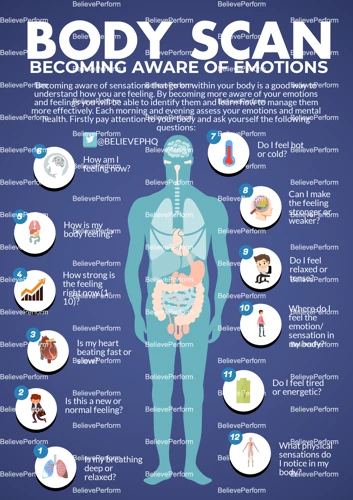
As we go about our daily lives, we often neglect the signals our body is sending us. We may not even be aware of the sensations we are experiencing. However, paying attention to our body can be a powerful tool for understanding our emotions. By becoming more attuned to our physical sensations, we can gain insight into our thoughts and feelings. In this section, we will explore various practices and techniques that can help us become more aware of our body sensations and use them to better understand our emotional lives.
Practices for Body Awareness
In order to become more aware of our body sensations and their connection to emotions, we can practice various techniques and exercises aimed at promoting body awareness. Here are some examples:
| Practice | Description |
|---|---|
| Body scan meditation | A guided meditation where the practitioner focuses attention on each part of the body in turn, noticing any sensations or feelings that arise. |
| Yoga | A physical practice that incorporates various poses and movements designed to increase flexibility, strength, and body awareness. |
| Progressive muscle relaxation | A technique that involves tensing and then releasing various muscle groups in sequence, promoting relaxation and awareness of bodily sensations. |
| Body-focused therapy | A type of therapy that addresses physical and emotional symptoms by focusing on bodily sensations and using techniques such as breathing and movement to facilitate emotional release. |
These practices can help us become more attuned to subtle changes in our body that may indicate the presence of certain emotions. By paying attention to our physical state, we can gain insight into our emotional experiences and develop a deeper understanding of ourselves.
Meditation and Mindfulness Techniques
A powerful tool for developing body awareness is through meditation. Meditation allows us to observe our thoughts and body sensations without judgment, creating a sense of mindfulness that helps us understand the connection between our mind and body. Through regular practice, we can develop the ability to be more present and tuned into our bodily sensations, which can help us to better understand and regulate our emotions.
There are many different types of meditation and mindfulness techniques that can be used to cultivate body awareness. Some popular techniques include:
| Mindful Breathing | Focus on the sensation of breath moving in and out of your body. Notice the rise and fall of your belly and chest with each inhale and exhale. If your mind wanders, gently bring your attention back to your breath. |
| Body Scan Meditation | Starting at the top of your head and moving down towards your toes, focus on each part of your body and notice any sensations you feel. Scan your body without judgment, allowing yourself to fully experience each sensation without labeling it as “good” or “bad”. |
| Metta Meditation | Also known as loving-kindness meditation, this practice involves directing positive intentions towards yourself and others. Sit in a comfortable position and repeat phrases such as “may I be happy”, “may I be healthy”, and “may I be at peace”. Then extend these intentions towards others in your life, including loved ones and those who may have caused you stress or discomfort. |
Practicing these techniques can help us become more attuned to our body sensations and emotions, ultimately leading to greater self-awareness and emotional regulation. Additionally, incorporating a regular meditation practice into our daily routine can have numerous benefits for our overall health and well-being, including reducing stress and anxiety, improving sleep, and increasing feelings of happiness and contentment.
Journaling and Self-Reflection
Journaling and self-reflection are powerful tools for increasing body awareness and understanding your emotions. Journaling involves regularly writing down your thoughts, feelings, and experiences in a notebook or document. This can help you identify patterns and themes in your emotions, as well as track changes in your mood over time.
When starting a journaling practice, it’s important to set aside dedicated time each day or week to write. Find a quiet and comfortable space where you won’t be interrupted, and try to write for at least 10-15 minutes each session. Don’t worry about grammar or spelling – the important thing is to get your thoughts down on paper.
Self-reflection involves taking time to examine your thoughts, feelings, and behavior, and identifying any patterns or tendencies. This can be done through journaling, meditation, or simply taking a few moments each day to check in with yourself.
To get started with self-reflection, try asking yourself probing questions such as “What am I feeling right now?” or “Why did I react that way in that situation?” Be honest with yourself, and don’t judge your thoughts or feelings – simply observe them.
By incorporating journaling and self-reflection into your daily routine, you can increase your body awareness and develop a deeper understanding of your emotions. Over time, this can lead to greater emotional regulation and a stronger sense of overall well-being.
Understanding Emotions through Body Sensations
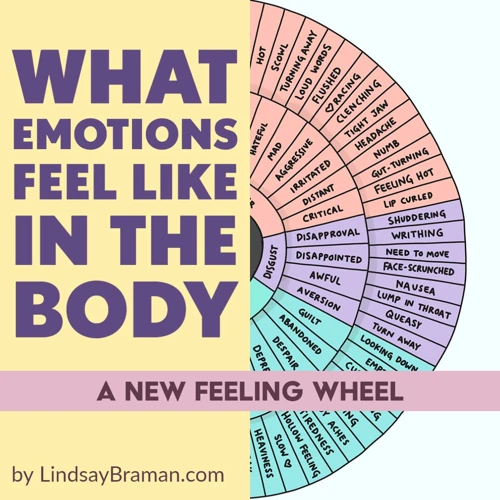
As human beings, we experience a wide range of emotions every day. Sometimes, it can be difficult to understand and express these emotions, leading to confusion and stress. However, it is possible to gain a deeper understanding of our emotions by paying attention to our body sensations. Sensations in our body can give us valuable clues about how we are feeling. In this section, we will explore how we can use body sensations to understand our emotions better. We will also discuss the role of intuition in emotional awareness and how spiritual practices can support us in this process.
Identifying Basic Emotions through Body Sensations
Identifying Basic Emotions through Body Sensations
Body sensations can provide important clues to our emotional state, and by paying attention to these sensations, we can learn to identify and understand our emotions in more depth. Here are some examples of basic emotions and the body sensations that often accompany them:
| Emotion | Body Sensations |
|---|---|
| Fear | Racing heart, tense muscles, sweaty palms |
| Anger | Increased heart rate, heat in the chest and face, clenched fists |
| Sadness | Heavy or constricted feeling in the chest, lethargy, slow movements |
| Happiness | Lightness in the body, relaxed muscles, smiling |
| Disgust | Tightening of the stomach muscles, nausea, aversion |
| Surprise | Quick or shallow breaths, widened eyes, tensed muscles |
| Shame | Facial flushing, drooping posture, avoidance of eye contact |
By becoming familiar with these sensations and learning to identify them in our own bodies, we can gain a greater understanding of our emotional states and what may be causing them. It’s important to note that everyone experiences emotions differently and may have their own unique bodily reactions, so it’s important to stay curious and open to exploring your own reactions and sensations.
Exploring Complex Emotions through Body Sensations
When it comes to complex emotions, such as jealousy or shame, it can be more challenging to identify the corresponding body sensations. These emotions often involve a mix of different feelings, making it difficult to pinpoint one specific physical sensation. However, with practice, it is possible to become more attuned to these sensations and use them as a tool for understanding and managing complex emotions.
One technique for exploring complex emotions through body sensations is to practice body scanning. This involves lying down or sitting comfortably and paying attention to each part of the body, noticing any sensations or discomfort. When a sensation is identified, take a moment to try to identify what emotion it may correspond to. It may be helpful to keep a journal or list of sensations and corresponding emotions to refer back to.
Another approach is to practice mindful breathing. This involves focusing on the breath and any sensations in the body as you inhale and exhale. When a complex emotion arises, take a moment to pause and focus on the physical sensations that come with it. This can help to separate out the different components of the emotion and gain a deeper understanding of its underlying causes.
It is important to note that exploring complex emotions through body sensations may not always be easy or comfortable. Some emotions may bring up painful or uncomfortable sensations, and it is essential to approach this practice with self-compassion and kindness. It may also be helpful to work with a therapist or counselor who can guide you through the process and provide support as you navigate complex emotions.
The Role of Intuition in Emotional Awareness
The role of intuition is crucial when it comes to emotional awareness. Intuition is the ability to understand something instinctively, without the need for conscious reasoning. Our intuition is like a sixth sense that provides us with insight beyond what our logical mind can comprehend. Intuition can be a powerful tool in identifying and understanding our emotions.
One way to tap into our intuition is by paying attention to our body sensations. For instance, when we are about to make a decision that could impact our emotions, our body often sends us signals. We might feel a knot in our stomach or a tension in our shoulders. Similarly, when we are in the presence of someone who triggers certain emotional responses, our intuition can guide us to recognize and respond to those emotions appropriately.
However, many people dismiss their intuition and rely solely on their rational mind to make decisions. This can limit their ability to fully understand and process their emotions. Learning to trust our intuition and pay attention to our body sensations can lead to greater emotional awareness.
Another way to tap into our intuition is through meditation and mindfulness practices. By calming our minds and focusing on the present moment, we can become more attuned to our inner voice and intuitive insights. Journaling and self-reflection can also provide opportunities to tap into our intuition by allowing us to explore our thoughts and feelings in a non-judgmental and introspective way.
The role of intuition in emotional awareness cannot be overstated. By paying attention to our body sensations and tapping into our intuition, we can develop a greater understanding and acceptance of our emotions.
How Spirituality Can Help
As human beings, we are complex creatures with intricate emotions that can often feel overwhelming. At times, our feelings may seem too powerful to manage, leaving us feeling lost and alone. While there are many resources available to help us understand and cope with our emotions, spirituality is one avenue that can provide a unique perspective for emotional well-being. Through practices that promote connection with the divine, we can cultivate a sense of inner peace and clarity that can aid us in understanding and managing our emotions. In this section of the article, we’ll explore how spirituality can be a valuable tool for emotional awareness and offer some practical tips for building a spiritual practice that supports emotional well-being.
Connecting with the Divine
When it comes to connecting with the divine, there are various practices that people follow. These practices can help individuals become more aware of their body sensations and emotions, leading to a greater understanding of themselves and their spirituality.
Here are some of the ways individuals can connect with the divine:
| Meditation: | Meditation is a form of spiritual practice that involves sitting in silence and focusing on the breath or a certain mantra. This practice helps individuals become more mindful and aware of their body sensations, allowing them to better understand their emotions. |
| Prayer: | Prayer is a form of communication with a higher power. Through prayer, individuals can express gratitude, ask for guidance, and find comfort in their beliefs. Prayer can also help individuals become more aware of their emotions and find inner peace. |
| Yoga: | Yoga is a physical and spiritual practice that involves movements, breathwork, and meditation. Through the practice of yoga, individuals can become more aware of their body sensations, emotions, and spiritual connection. |
| Nature: | Spending time in nature can also be a form of spiritual practice. Being surrounded by natural beauty can help individuals become more present and mindful, leading to a greater understanding of their body sensations and emotions. Whether it’s going for a walk in the park or hiking in the mountains, nature can be a powerful tool for spiritual connection. |
| Creative expression: | Engaging in creative activities such as writing, painting, or music can also be a form of spiritual practice. Through creative expression, individuals can better understand their emotions and express their spirituality. |
Connecting with the divine can lead to a deeper understanding of one’s body sensations and emotions, as well as a greater sense of spiritual connection and well-being.
Building a Spiritual Practice for Emotional Well-being
A spiritual practice can play an important role in promoting emotional well-being, and it doesn’t have to be complicated or time-consuming. Here are some ideas for building a spiritual practice that can help you connect with your emotions and promote healing:
- Meditation or prayer: Taking time each day to still your mind and connect with a higher power can help you cultivate a sense of inner peace and calm. Whether you prefer guided meditations, silent prayer, or some other form of spiritual practice, making time to connect with your inner self and the divine can help you cultivate greater emotional awareness and resilience.
- Gratitude practice: Focusing on the good things in your life and expressing gratitude for them can help shift your perspective and bring more positivity into your emotional landscape. Consider starting a gratitude journal or making a daily list of things you’re thankful for.
- Acts of service: Doing things for others can help take the focus off of your own problems and connect you to a sense of purpose and meaning. Whether it’s volunteering at a local charity, helping a friend or family member in need, or simply performing small acts of kindness throughout the day, acts of service can help build emotional resilience and promote feelings of connection and well-being.
- Mindful movement: Movement practices like yoga, tai chi, or dance can help you connect with your body and access your emotions in a more embodied way. These practices can also help reduce stress and promote relaxation, which can be especially helpful for individuals who struggle with anxiety or other intense emotions.
- Connection with nature: Spending time in nature can be incredibly healing and restorative. Whether it’s a walk in the park, a hike in the mountains, or a day at the beach, being in nature can help you connect with a sense of awe and wonder, and remind you of the bigger picture beyond your own emotional struggles.
Remember, building a spiritual practice for emotional well-being is all about finding what works for you. Experiment with different practices and see what resonates with you. Even small changes in your daily routine can have a big impact on your emotional health over time.
Conclusion
After exploring the role of body sensations in understanding our emotions, it is clear that there is a deep connection between what we feel in our bodies and what we feel in our minds. By becoming more aware of our physical sensations and tuning into them, we can gain a greater understanding of our emotional experiences.
The link between spirituality and body awareness cannot be ignored, as many spiritual practices emphasize the importance of mindfulness and present moment awareness. These practices can be incredibly beneficial for individuals seeking to deepen their emotional literacy and connect with their inner selves.
From a scientific perspective, there is ample evidence to suggest that our gut and brain are inextricably linked, and that our physical sensations can provide valuable clues to our emotional experiences. By tuning into the sensations in our bodies, we can learn to identify and label our emotions, paving the way for greater emotional regulation and well-being.
There are many different techniques and practices that can help us become more aware of our body sensations, from meditation and mindfulness to journaling and self-reflection. By incorporating these practices into our daily lives, we can slowly but surely develop greater emotional intelligence and self-awareness.
It is worth noting that tuning into our body sensations and emotions can sometimes be uncomfortable, and it is important to approach this process with self-compassion and patience. The journey of emotional awareness is a lifelong one, and it is okay to make mistakes and experience setbacks along the way.
Ultimately, incorporating spirituality into our lives can provide a valuable framework for emotional well-being and growth. By building a spiritual practice that resonates with us, we can cultivate a deeper sense of meaning and purpose, and connect with something greater than ourselves.
In conclusion, the role of body sensations in understanding our emotions is a complex and multifaceted topic, but one that is of utmost importance to our emotional well-being. By cultivating greater self-awareness and tuning into our physical sensations, we can learn to navigate complex emotional experiences with greater ease and grace.
Frequently Asked Questions
What is the mind-body connection?
The mind-body connection refers to the link between our physical sensations and our mental and emotional state. It suggests that our thoughts and feelings can impact our physical well-being, and vice versa.
How does spirituality impact body awareness?
Spirituality can help individuals become more aware of their body by promoting mindfulness and meditation practices, which allow us to pay attention to physical sensations and emotions without judgment.
How do sensations provide clues to our emotions?
Sensations, such as tightness in the chest or a churning stomach, can indicate different emotions like anxiety or fear. By paying attention to our physical sensations, we can better understand and manage our emotions.
What is the gut-brain connection?
The gut-brain connection refers to the communication pathway between the digestive system and the brain. This connection can impact our mood and emotional state and is being studied for potential therapeutic interventions.
What practices can help increase body awareness?
Practices such as meditation, yoga, and journaling can help individuals become more aware of their physical sensations and emotions. Mindfulness techniques, such as deep breathing and body scans, can also be helpful.
Can spirituality help with emotional well-being?
Yes, spirituality can provide individuals with a sense of purpose and meaning, which can contribute to emotional well-being. Additionally, spiritual practices, such as prayer or meditation, can promote relaxation and stress reduction.
How can body sensations help us understand complex emotions?
Body sensations can provide us with insight into our emotions, including complex ones. For example, a tightness in the chest and difficulty breathing can signal feelings of grief or sadness, even if we are not consciously aware of them.
How important is intuition in emotional awareness?
Intuition can play a significant role in emotional awareness. Our intuition or “gut feeling” can often signal when something is off or when we are experiencing an emotional response, even if we don’t yet have a clear understanding of why.
How can spirituality help us connect with the divine?
Through spiritual practices such as prayer, meditation, and contemplation, individuals may feel a closer connection to a higher power or divine force. Spiritual experiences can provide individuals with a sense of awe, wonder, and meaning.
What is the connection between spirituality and emotional well-being?
Research suggests that spirituality can contribute to emotional well-being by providing a sense of purpose and meaning, promoting relaxation and stress reduction, and improving social support and connectedness.

